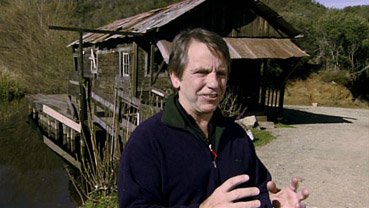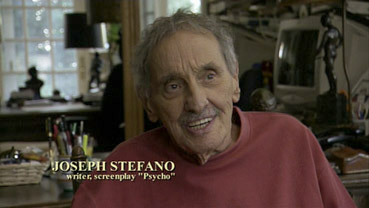|
I
have a couple of things in common with the makers of Going
to Pieces, a lively and affectionate look at that
most maligned of horror sub-genres, the Slasher Movie. For
a start, I share their unbridled enthusiasm for the film
that started it all, John Carpenter's 1978 Halloween,
and like them I've seen a great many of the similarly themed works that
sprang up in its wake. It's not that I was a huge
fan of this emerging sub-genre, it's just that I, like a good many others, kept hoping to encounter another film that was as good as the one from which the trend exploded.
In these early days of sub-standard copycat cheapies, I
never got one. What
I got was a formula. It went something like this:
Take
one group of teenagers who are out for a good time. It helps
if they're horny and stupid, then they'll say things like
"let's have a party in that old abandoned mine"
and be too busy shagging to spot the danger signs. Add to
the mix one deranged killer, preferably masked and/or deformed.
Plant both parties in the same location and watch as the
killer picks off the teenagers one by one in varied and
ideally bizarre ways. If you have sex you die, if you stay
pure you'll probably live and outsmart the monster. Oh yes,
and make sure you save your biggest surprise for the end when everyone (except those who've seen a slasher film
before) thinks it's all over. Shove in the cinema and bake
for about 90 minutes.

A
few followed Carpenter's lead and tried to play it for tension,
but it soon became clear that audiences were identifying
more with the killers than their victims. Hardly surprising,
really, as low budgets and bandwagon-jumping meant that
few of the filmmakers were that interested in searching for the next Jamie
Lee Curtis. Girls started to get roles because they were
prepared to bare their breasts and be covered in blood, guys
because they'd spent some time in the gym. Irritating at
best, obnoxious at worst, they seemed almost designed for
an audience to enjoy seeing torn asunder.
And
yet, as with any horror sub-genre, these films have an inexplicably
endearing appeal. At least they do now. With recycled horror
presently in the hands of studios and pumped up with budgets that allow
for all sorts of CG silliness, I actually miss the sometimes
inventive do-it-yourself cheapness of the early slasher films. It's such nostalgia
that Going to Pieces very effectively taps
into and trades on, and this helps give it an appeal beyond cult fandom.
Indeed, its lively, rock 'n' roll handling may well sink
a hook into horror fans to young to have experienced the genre's
first wave.
Based
on the book by Adam Rockoff and driven by a blend of interview, archive material
and film extracts, Going to Pieces follows
a linear timeline from Halloween and Friday
the 13th through the flood of 80s stalk-and-slash
cheapies, to the revivals kicked off by Wes Craven with A
Nightmare on Elm Street and Scream.
Genre writers are interviewed alongside actors and filmmakers,
who take us through the making and release of some of the
genre's most notorious works. The formulaic nature of the
genre is not just acknowledged but openly celebrated, as
is the unabashed enjoyment of gratuitous on-screen violence.
The critical reaction against the films is represented by a stern
condemnation from Gene Siskel and Roger Ebert, which we are
encouraged to disagree with. The problem is that
they actually do make a couple of valid points that deserve
a more considered response than "no it isn't,"
or the convention fan whose pearl of wisdom is "I think
there was violence in society before horror movies and there's
gonna be violence in society after horror movies."
No shit, Ms. Sherlock. Mind you, when it gets to the controversy
surrounding the murderous Santa in Silent Night,
Deadly Night, I found myself groaning at the family
values protestors and firmly aligning myself with the dark side.
The
early 80s quality plunge and the socio-political context
in which the films were able to thrive are discussed, and
there are plenty of valid and thoughtful observations
on the genre's qualities and the passion of its fans. Enlightening
and entertaining, the backbone of the film is its sometimes
excellent interview material, with contributors such as John
Carpenter, Sean S. Cunningham, Bob Clark, Paul Lynch, Betsy
Palmer (who played Mrs. Voorhees in Friday the 13th),
Rob Zombie, the super-smart Wes Craven, the always engaging
Tom Savini, and a whole load more. Collectively, this proves
so informative and so cheerfully enthusiastic for its subject
that I find myself genuinely tempted to dress up and
run off to a horror convention and to hunt out and re-evaluate
even the films I was initially pissed off by. It also handily
reminded me that the bad slasher movie overload I suffered
in the early eighties has, over the course of the genre's
history, been balanced by a number of very worthy films
that have rightly taken their place in the horror hall of
fame.

It
may have its omissions and skim over some areas, but there were clearly problems obtaining the rights for some of the desired but absent clips and there's only so much ground you can cover in 88 minutes. For the most part, though, Going
to Pieces is a comprehensive, well researched and thoroughly entertaining
guide to a sub-genre that's had peaks and troughs, but stubbornly
refuses to die.
Framed 1.77:1 and anamorphically enhanced, the picture quality
varies a little from interview to interview, depending on
the lighting and location and the recording medium, but
at its best this is a fine transfer with very good contrast,
colour and detail, especially considering it appears to have been converted from an NTSC original. The quality of film extracts is far more
variable, but the filmmakers were at the mercy of what they
were supplied with or had access to here.
The Dolby 2.0 stereo track is a little uneven, largely due
to a surprising variance in interview sound recording quality,
which can be alternately clear, fluffy and even
a little tinny. The mix does not always balance the music
and dialogue as well as it might, but for the most part
it's clear enough.
Commentary with producers Rachel Belofsky, Rudy Scalese
and editor Michael Bohusz
One of those commentaries in which the filmmakers are initially slapping
each other on the back with such frequency and gusto that I'm
amazed none of them sustained severe spinal injury or lost
a lung. If you get weary listening to people talking about
how much they love this shot, sequence, person or whatever
then you're likely to find yourself reaching for an axe after the
first fifteen minutes. But this does settle down a bit and
we do get some insight into the featured films and the problems
the filmmakers had putting the documentary together, not
least the issue of clearing the rights on film extracts
and the varying responses they had to their requests, from
the unnamed blonde actress who wanted too much for her Nightmare
on Elm Street clips to the ever-helpful Tom Savini, who
cheerfully supplied the team with his own behind-the-scenes
footage of his work on Friday 13th: The Final Chapter.
Extended Interviews
A welcome and sometimes delightful collection of interview
material not used in the film: John Dunning (4:58) entertainingly talks about the making of My Bloody Valentine; Paul Lynch (3:00) amusingly explains the conception of Prom
Night; Bob Clark (5:35) talks about Black Christmas and
sets the record straight on its influence on Halloween; Fred
Walton (6:01) outlines the development of When a Stranger
Calls; and Stan Winston (2:52) briefly discusses Friday the
13th Part III. Best of all is Joseph Stefano (10:10), who
compellingly recalls working with Alfred Hitchcock on Psycho.
There are three multiple choice genre quizzes. All three are rather
fun, though strangely I did better on Seasoned Gorehound
Challenge and the True or False Quiz than on Burgeoning Gorehound Challenge.
The Trailer (1:19) is a very nifty and well assembled sell.
Made by true genre fans and targeted primarily at their
brethren, Going to Pieces is enjoyable and enlightening
enough to reach a wider audience, although potential viewers
be warned – the violence in the chosen film extracts is
spectacularly nasty stuff and definitely NOT for the faint
hearted or easily offended.
Metrodome have delivered a decent DVD here, a good transfer backed up by some excellent additional interviews,
three fun quizzes and a commentary that is genuinely interesting
when it isn't annoying. Dedicated horror fans should consider
it an essential purchase – the rest of you might want
to consider your gore tolerance level before proceeding.
|